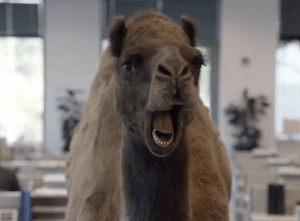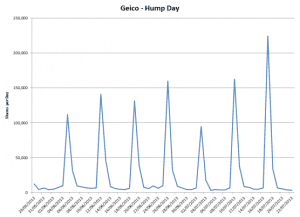Nir’s Note: Jonah Berger is a marketing professor at the Wharton School and author of the New York Times bestseller Contagious: Why Things Catch On. Contagious explains the science behind word of mouth, how six key factors drive products and ideas to become popular, and how you can apply that science to get your own stuff to catch on.

Whether you run a small business or work for a large one, and whether you sell a product or offer a service, everyone wants their stuff to catch on.
More users, more sales, and more growth.
But why do some products and ideas become popular while others fail? And how can we harness that science to make our own products and services more popular?
One of the most shared campaigns of 2013 was GEICO’s Hump Day ad.
It stars an annoying camel walking through a crowded office interrupting people. “Guess what day it is?” he bellows. People roll their eyes and try to ignore him, but he persists. “Julie! Hey…guess what day it is??? Ah come on, I know you can hear me.”
Finally, he finds someone who responds. “It’s Hump Day,” she says. “Whoot Whoot!” yells the camel. “How happy are folks who save hundreds of dollars switching to GEICO?” a voice intones, “happier than a camel on Wednesday.”
The ad is funny, but it’s not that funny. And GEICO didn’t spend more money showing this ad than its others.
So why was the ad so successful? Why did over 20 million people share it?
One clue comes from analyzing the temporal pattern of share data. If you look at the number of people sharing GEICO’s Hump Day Ad over time, you’ll notice an interesting pattern. There is a spike in shares and then it goes down. Then another spike and it goes down. And so on, again and again.

Look closer though and you’ll notice that the spikes are not random. In fact, they’re exactly seven days apart. And if you look even closer you’ll notice that they’re always on the same day of the week.
That day? Wednesday.
Or as it is colloquially known, Hump day.
GEICO’s ad is equally bad (or good, depending on your preferences) every day of the week.
I’ve checked. It’s good or bad on Monday, good or bad on Tuesday, good or bad on Wednesday, etc.
But Wednesday provides a ready reminder, what psychologists would call a trigger, to make people think about (and talk about) the GEICO ad. Because if something is top-of-mind, it’s much more likely to be tip-of-tongue.
The Power of Word of Mouth Marketing
Word of mouth advertising drives all sorts of products and ideas to catch on.
It’s 10 times more effective than traditional advertising and shapes everything from the products people buy to the services they use.
But why do people talk about some things rather than others?
It might seem random. Just chance that one product or app or service gets more buzz than another.
But it’s not…
As I talk about in Contagious: Why Things Catch On, six key factors, or what I call STEPPS, drive all sorts of products and ideas to become popular.
Take triggers. If someone said “cats and…” you might immediately think of, well, dogs. If someone said “peanut butter and…” you might immediately think of jelly. Peanut butter is like a little advertisement for jelly. Seeing, hearing, or even thinking about peanut butter makes people think about its frequent partner, jelly.
And because triggers make things top-of-mind, they also shape what we talk about and how we behave.
Hershey’s effectively used triggers to help reinvigorate the Kit Kat brand. Sales were down and Hershey’s needed to get people thinking about Kit Kat again. So they started linking Kit Kat to coffee. Taking a coffee break? Have a Kit Kat. Thinking about coffee, think about Kit Kat. Kit Kat and coffee. Coffee and Kit Kat…
…Best friends forever.
Twelve months later, sales were up almost 40%.
Why?
Because linking Kit Kat to coffee helped remind people of the brand. And coffee was a great trigger because many people drink coffee frequently, multiple times a day. Making it more likely that they would think of Kit Kat frequently as well.
What’s Your Peanut Butter?
What’s the thing in the environment that will remind people of your product, service, or idea, even if you’re not around?
Because you can spend a lot of marketing dollars trying to remind people you exist, or you can link yourself to a trigger and the environment will do the reminding for you.
Every time people see that peanut butter, they’ll think of you.
Generating good word of mouth or getting your product or advertising to go viral sometimes seems like magic. Like catching lightning in a bottle…
…But it’s not.
There’s a science behind it. Triggers are only one of the six key principles that drives all sorts of things to catch on – including word of mouth marketing ideas.
Understand that science, and you can make your own products and ideas more contagious.
Related Articles
- Schedule Maker: a Google Sheet to Plan Your Week
- Cancel the New York Times? Good Luck Battling “Dark Patterns”
- How to Start a Career in Behavioral Design
- A Free Course on User Behavior
- User Investment: Make Your Users Do the Work
- Variable Rewards: Want To Hook Users? Drive Them Crazy
- The Hooked Model: How to Manufacture Desire in 4 Steps
